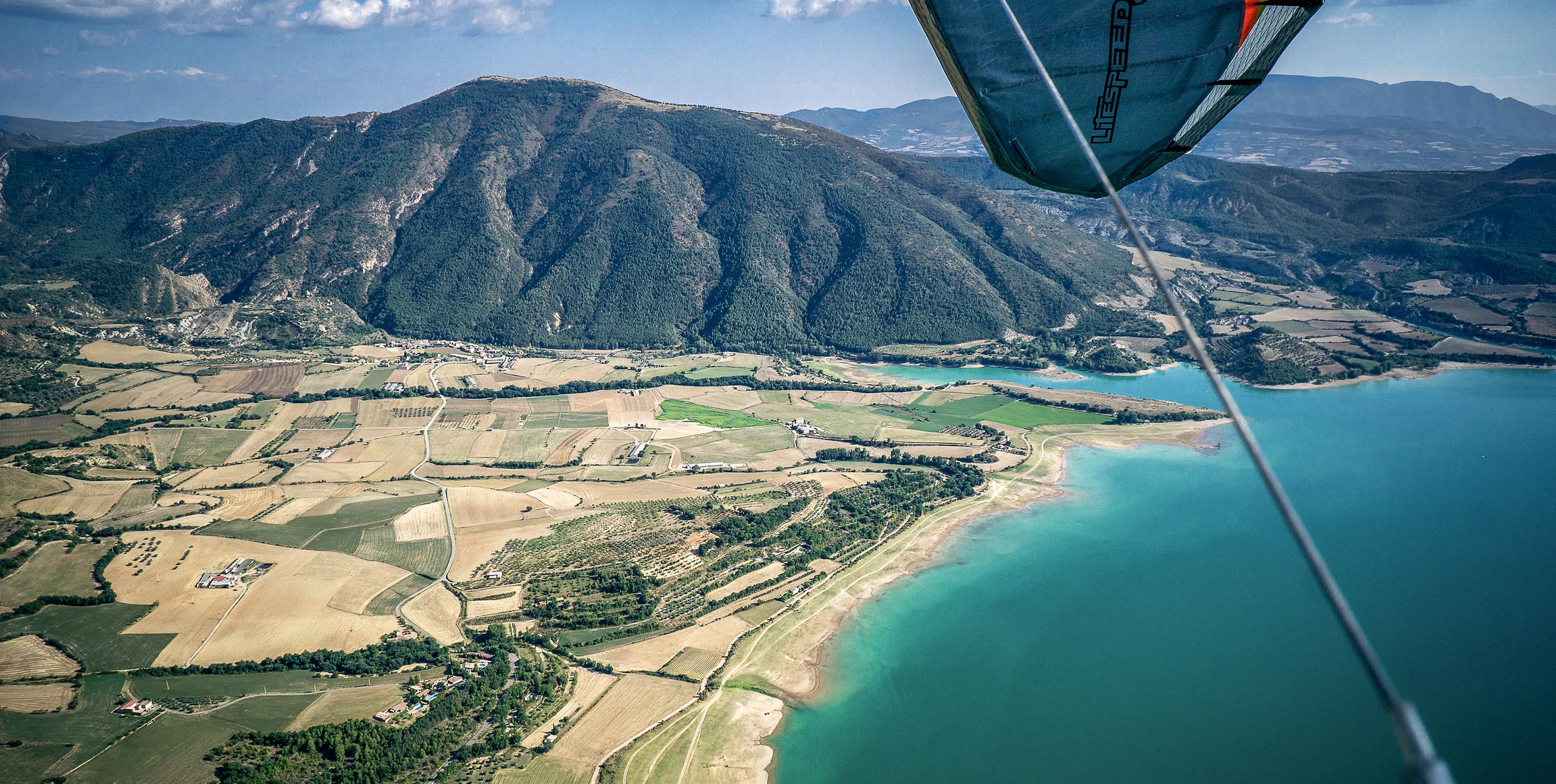
Lawrie Noctor flies this lightweight paramotor made of titanium with a carbon-fibre option.
French company MacFly was founded in 2010 by paragliding and paramotoring instructor Jean Mateos after 20 years in the sport. Jean decided to start producing his own machines for his then teenage children. Roll on another 12 years and now between Jean, Alex, Coralie and Marie they have 17 world and national paramotor championship titles between them. Paramotoring for the Mateos clan is truly a family sport. This is a seriously impressive pedigree which no other manufacturer can claim.
The MacFly 185 has been around for at least three years. The frame is built entirely of titanium, which of course makes it light. In 2020 it was made even lighter with the addition of optional carbon-fibre spars, making it an even more attractive option for those who travel with their paramotor.
However, with flying in 2020 and 2021 seriously curtailed by the pandemic and various lockdowns, it wasn’t until the summer of 2022 that I finally got the chance to properly fly the MacFly 185. I was excited to get into it.
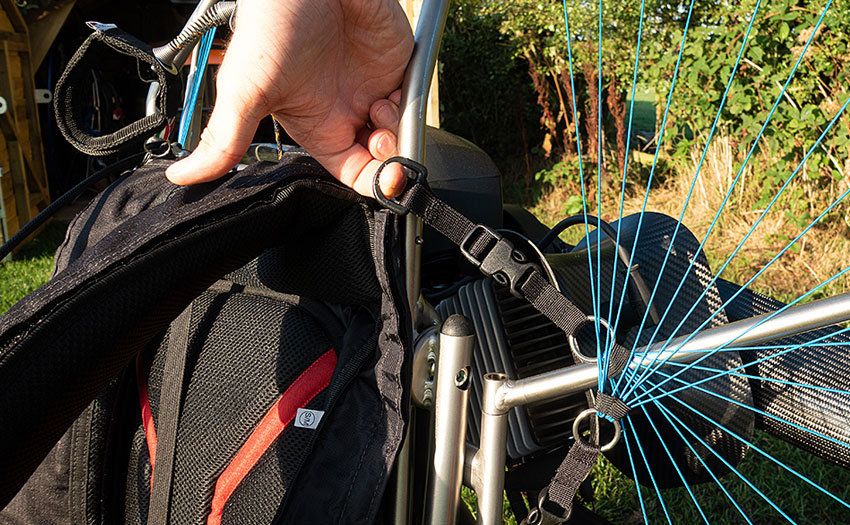
Putting it together
Now, if you are unlucky and need to dismantle and build the motor each time you use it then you’ll be pleased to know that the MacFly 185 is actually pretty easy to put together. There are a few little bits to get used to, like how the netting needs to sit, but other than this it is plain sailing.
In total there are four spars which need to be added onto the main frame and then four sections of outer cage. Once these are in place, which only takes a couple of minutes, all you need to do is attach the four plastic buckles from the netting to the frame. If, as for me was the case, the netting appears to be loose in some places simply go along each line and gently pull it until taut. Once even across the range use the plastic buckle to pull on tension. Voilà you are good to go!
The only niggle I had was with the small metal compressible pins that pop out of one part of the cage and into another, to hold the parts together. These can be fiddly to insert in the first place and sometimes are very delicate. This is not isolated to MacFly though, as I know a lot of other manufacturers use the same method, so a redesign here would be nice. The pins are only used to attach the pre-drilled carbon fibre spars; the titanium frame spars have no holes for them.
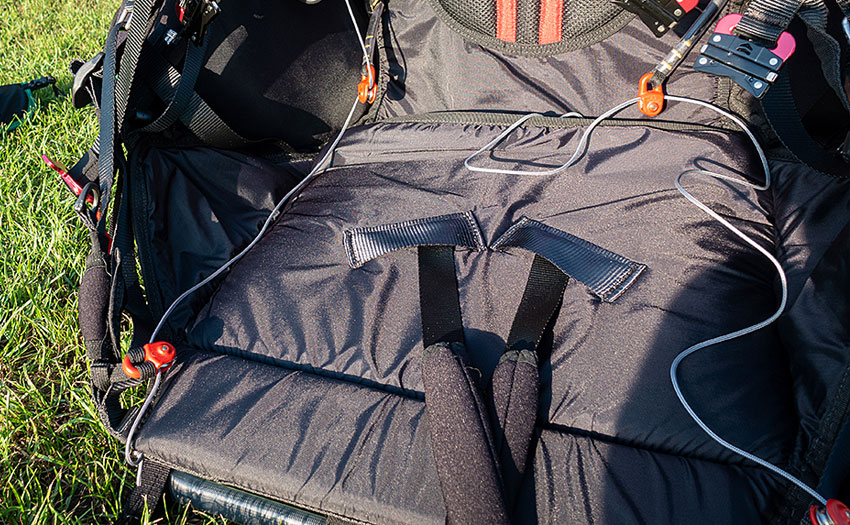
The harness is a Sol M/S harness and is very well integrated onto the frame. There are some nice touches on this. For example, the reserve compartment (which can be mounted left or right depending on pilot needs) is zipped on but then also has a buckle to tighten the gap towards the top of the zip to help stop it from loosening. It also has a Velcro cover over the zip, as well as a little extra zip which folds back and has a stopper on it. Sounds simple, but on previous motors I have noticed the zip coming undone, especially with bigger reserves.
The reserve routing is easy. The only small thing here is it would be nice to have a little more fabric on the shoulder straps to accommodate bridle and maillons. On a couple of occasions I found that, because the fabric had to stretch over this onto the Velcro to close, occasionally it came apart.
Regarding storage the MacFly/Sol combo has a side zipped pocket (opposite the reserve) and an underseat storage compartment (also zipped). I found that generally there was more than enough space for the usual items (phone, keys, spare oil, small toolset). And indeed, I could also fit my small glider bag stuff sack into the underseat compartment.
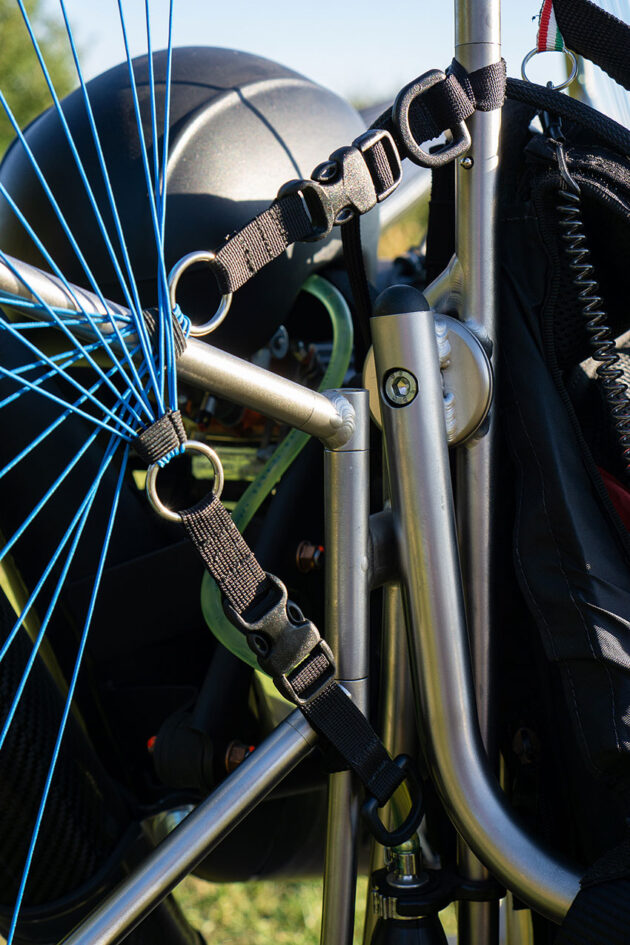
On the ground
The model I had for review came with the Moster 185 engine. I won’t go into details on the engine as it’s a widely known component, but it fits well for me because of its balance of weight and thrust.
Fuelling the MacFly 185 can be a little tricky as the fuel cap is awkward to get to – just behind the exhaust – and there is not quite enough room to get to it from the side. It’s certainly not a dealbreaker but it’s a little awkward.
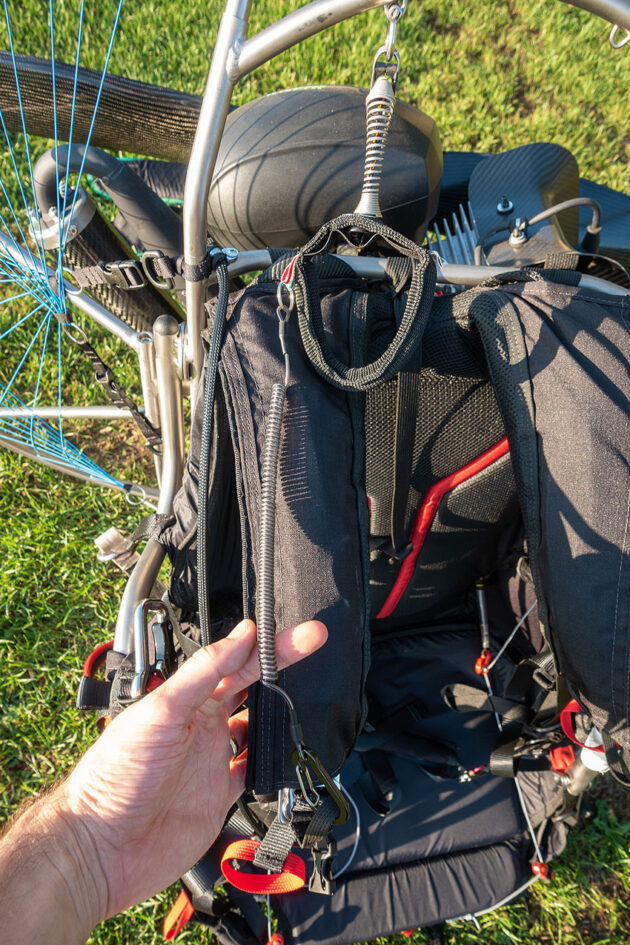
Fuelled up and ready, standing up with the motor on my back for the first time I noticed just how comfortable it is. I think the mix of harness used and geometry of the frame makes this one of the most comfortable paramotors I have flown in recent years. I could move around easily without feeling any pinch points or pressure points and was able to get nice long strides on my take-off run whilst leaning back. The motor is available with two harnesses: a Supair (in S, M, L sizes) or the Sol harness in S/M and X/XL sizes. I am about 72kg and 5’10” (178cm) and used the Sol S/M harness and it fit well.
Starting the motor was also nice and easy as MacFly provide an elasticated cord which runs from the starter handle to the shoulder strap. Gone are the days of scrabbling around with your arms trying to find the start cord behind you. This also makes in-flight restarting much easier.
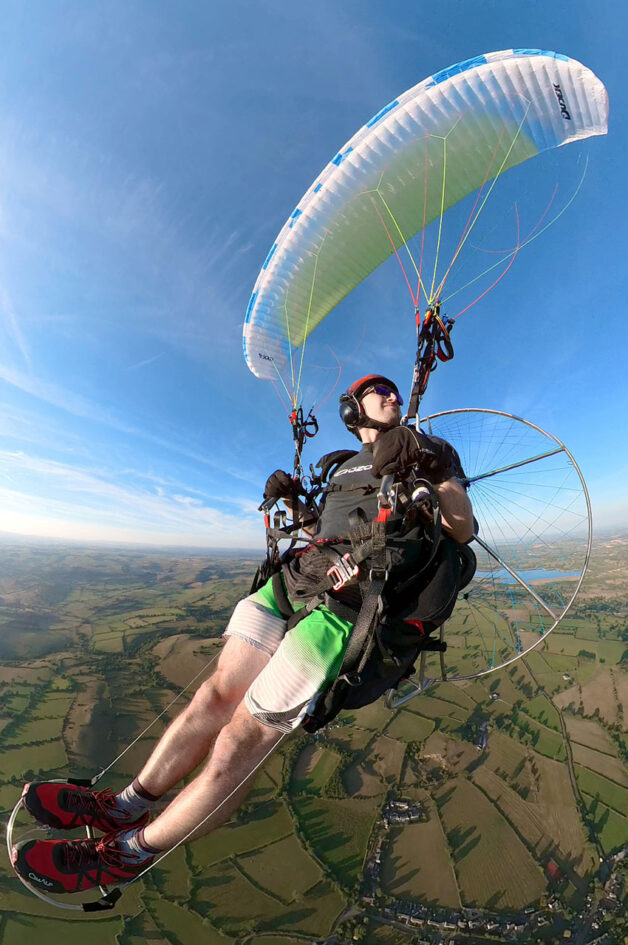
In the air
Once airborne I felt straight at home and comfortable. Going from the leg loops position to seated was simple just with a raise of the knees and a wiggle of the bum – easy. Typically, when I fly new paramotors I will do a series of 360 turns in both directions followed by some gentle wingovers just using weightshift. I was pleasantly surprised by how easy it was to weightshift turn with the MacFly 185 and indeed I would say it was a little ahead in this respect compared to other paramotors I have flown recently.
Using the speed system was straightforward enough. However, I found it a little odd that the routing of the speed system is just under your bum as opposed to having plastic tube channels built into the small side-wall of the harness
During the whole time of testing this was not an issue, and I did not find any signs of wear and tear, but it would be nice to have dedicated routing for minimal resistance and longevity.

I found that both styles of speed bar use (standard seated or leg loops upright) was comfortable and there was plenty of adjustment in the harness to get the comfiest position for all phases of flight. Switching between these positions, whether that be in leg loops and moving back into the harness or using speed bar and coming off back into relaxed positions, was seamless and could be done without too much thought.
For review I was given both the standard titanium cage tubes and the carbon aero tubes. I decided to start flying straight away with the carbon aerotubes. At low power, low airspeed flight configurations I couldn’t notice much difference. Even at the higher airspeed phases of flight I would say the difference they make is small, but there is a difference. Because of this, for me personally I wouldn’t have these as an option at additional cost. But I can see people who want the ultimate performance – or just to have a different looking motor – choosing them. (It did look very nice having carbon aerotubes/wings and titanium together).
I tried some more ‘’extreme’’ flight manoeuvres with the MacFly to see how it behaved, including stalls, loops, spins and wingovers. It reminded me of my paragliding race harness in that it’s manoeuvrable when you want it to be but comfortable and stable when things are a little fruity. I felt in full control with the harness/motor geometry with enough weightshift to be able to get the wing to do exactly what I wanted.
I should add that the more dynamic moves I did with engine off, so I had no influence from gyroscopic forces or thrust.
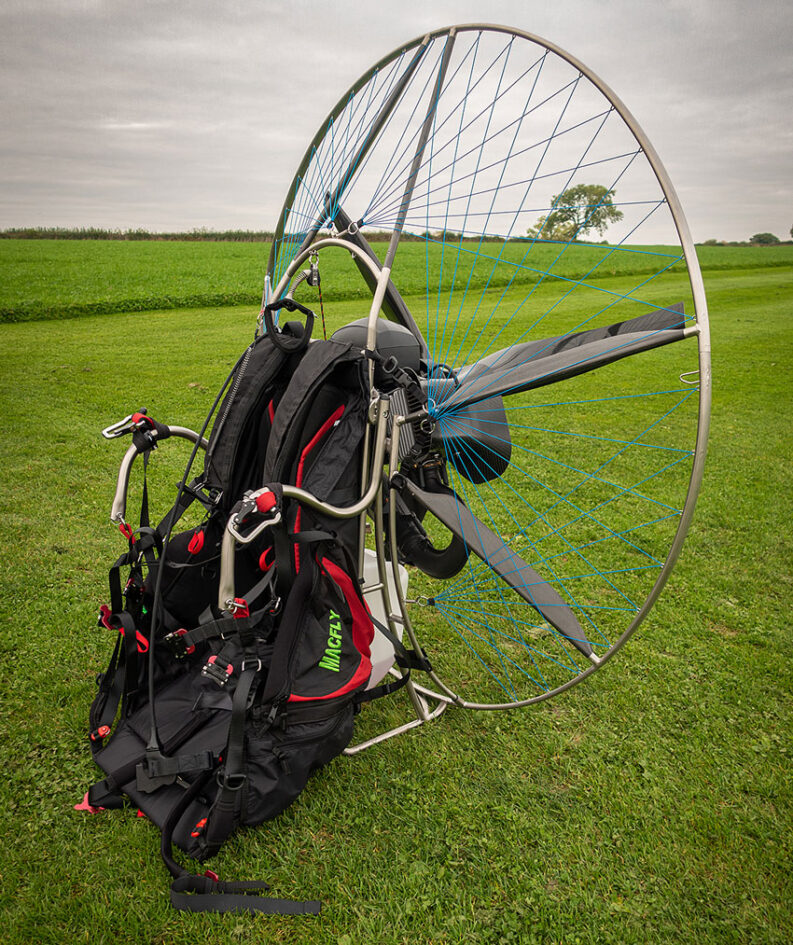
The verdict
The MacFly 185 frame looks lovely and is well made. It’s easy to put together and comfortable in the air and on the ground. Other than a few niggly little bits it is hard to fault. I could happily recommend this to both low airtime pilots and pilots who have been flying a little longer.
Manufacturer’s specifications
What MacFly say: “Light but powerful, a very interesting engine for those who wish to practise and evolve effectively”
Use: Intermediate paramotor pilots and above
Engine: Moster 185
Frame: Custom made titanium, 138cm diameter
Arms: Titanium swan neck swing arms
Harness: Sol S/M harness or Supair S, M and L
Start: Manual start, optional electric start available
Cage spars: Titanium or carbon-fibre (sold separately)
Fuel tank: 12 litre
Weight: 25kg
Lawrie Noctor flew the MacFly 185 at between 102-110kg with two different wings, a Freeride 16m and Dudek Solo 24, to give the best idea on handling with different wing types. He used the Sol M/S harness.
Published in Cross Country 235 (November 2022)




